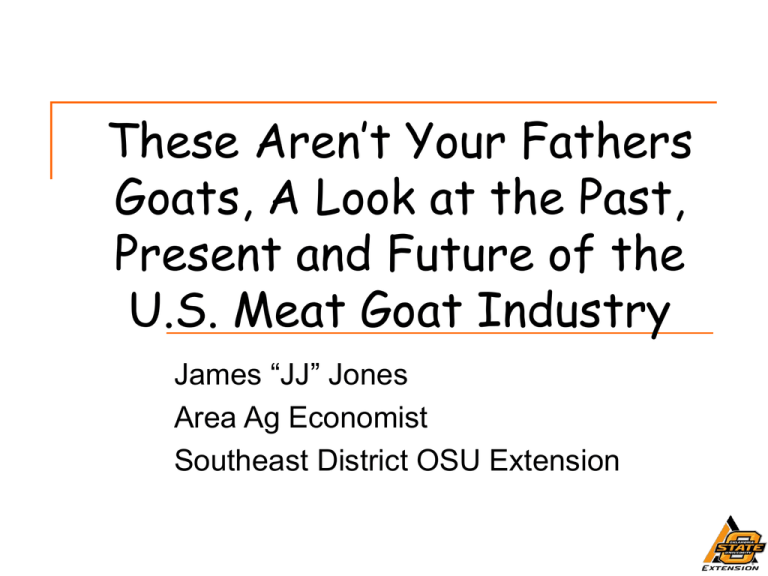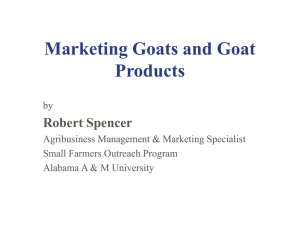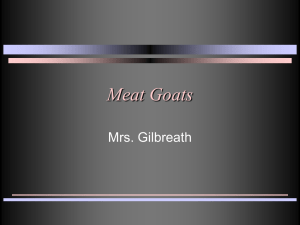Goat Industry in the U.S. and Oklahoma
advertisement

These Aren’t Your Fathers Goats, A Look at the Past, Present and Future of the U.S. Meat Goat Industry James “JJ” Jones Area Ag Economist Southeast District OSU Extension Goat Industry before 1990 Dairy • Cheese Mohair • Government program cut from farm bill Brush Goat Industry after 1990’s Started importing African meat goats in mid 90’s Started with Boer goats Now are there are 3-5 distinct meat goat breeds in the U.S. USDA started counting meat goats in 2004 Why the increase? Goat meat is consumed by: • • • • • Muslims Hispanic Europeans Asians Africans Seems to be limited by supply Future demand? Industry Overview 2006 Demand Slaughtered (official) Imported Slaughtered (unofficial) Mil. Lbs 20.4 24.5 3.5 48.4 2007 U.S. Meat Goat Numbers > 1,000,000 100,000 1,000,000 75,000 100,000 50,000 75,000 3 7 30,000 50,000 10,000 30,000 5 8 2 4 1 9 < 10,000 Source: NASS 6 U.S. Total: 2,400,000 Southern Region Goat Numbers Texas (1) 1,080,000 Tennessee (2) 103,000 Georgia (3) 95,000 Oklahoma (5) Kentucky (7) North Carolina (8) Florida (9) 74,000 68,000 60,000 55,000 South Carolina (10) Alabama (11) Virginia (12) Arkansas (14) Mississippi (18) 44,000 43,000 41,000 29,000 24,000 Louisiana (27) Total 12,800 1,728,800 or 72% of the U.S. goats 76.5% of U.S. Total 2005 U.S. Inspected Slaughter U.S. Total: 566,208 head 7. Illinois 25,660 4.5% 8. Indiana 22,899 4% 3. Pennsylvania 4. New York 37,041 33,459 6.6% 5.9% 1. New Jersey 209,156 37% 9. California 22,214 3.9% 6. DE/MD 25,682 4.5% 2. Texas 38,079 6.7% 5. Tennessee 29,692 5.2% 10. Florida 15,610 2.7% Types of Goat Operations 1. Brush Control • Used as weed eaters • Profit is not the motive 3. Purebred or Seed Stock • • • • Higher start up costs Build a reputation Breed association Registration of animals 2. Multi-Species Grazing • Compliments other livestock enterprise • Profit can be a motive 4. Commercial Goat Operation • Produce kids for meat production • Manage for profit maximization Holiday Demand Holiday Date Type of goat Easter (Western) April 8, 2007 March 23, 2008 April 12, 2009 20 to 50 pounds Easter (Eastern and Greek) April 8, 2007 April 27, 2008 April 19, 2009 20 to 50 pounds Independence Day July 4 20 to 35 pounds Caribbean holidays August 60 pound bucks Holiday Demand Holiday Date Type of goat Start of Ramadan (Muslim) September 13, 2007 September 8, 2008 August 22, 2009 45 to 120 pounds less than 12 months Eid al Fitr (Muslim) October 13, 2007 October 2, 2008 September 21, 2009 45 to 120 pounds 60 pounds optimum Eid al Adha (Muslim) December 20, 2007 December 8, 2008 November 28, 2009 Yearlings, blemish free Dassai (Hindu) October 12, 2007 September 30, 2008 Male goats only, size depends upon number being fed Why are goats popular? Perfect for a small producer with limited: • Land • Capital (although can be higher than first thought) • Equipment Can be profitable • OSU budget shows a return of $35/head Show goats • Around 1800 kids with goat projects Goat Industry Challenges Production diversity and multiple products Demand diversity Demand future • Will future generations continue to eat goat? Geographic dispersion of production and consumption Seasonality of supply and demand Fragmented and limited market infrastructure Lack of market information Lack of research on goat production What about the future? Goat numbers continue to increase. • Theoretically could increase goat herd by 500,000. • Show goat projects continue to increase. Currently have not reached saturation point. It is not the ostrich market all over again. It is not your dad’s goat farm. As long as there is a demand for the final product there will be a viable market. Questions?






